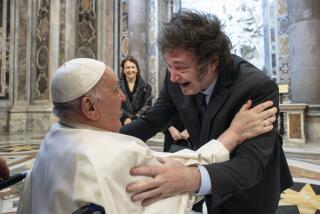Pope Beatifies Nun Who Inspired Parts of ‘Passion of the Christ’
- Share via
VATICAN CITY — It isn’t often that a potential saint has a resume that could include a Hollywood screenplay.
But on Sunday, the 19th century mystic nun who inspired some of the more controversial scenes of Mel Gibson’s hit movie, “The Passion of the Christ,” was beatified by Pope John Paul II.
Beatification is the last formal level before a person is elevated to sainthood. In addition to Sister Anne Catherine Emmerich, a German nun known for her purported visions of Jesus’ crucifixion, the pope beatified the last reigning emperor of Austria, two French priests and an Italian nun.
The ailing, 84-year-old pontiff, whose schedule has been greatly curtailed as he marks his 26th year in the papacy this month, struggled to deliver Sunday’s homily. He has beatified more people than all his predecessors combined.
Emmerich shared the “bitter suffering” of Jesus Christ and dedicated her life to “complete, loving devotion of him,” the pope said in a regal ceremony in St. Peter’s Square before an estimated 25,000 worshipers and tourists.
The frail, bedridden nun was said to have borne stigmata -- bloody wounds on the hands, feet and forehead like those suffered by Christ -- and when reveling in visionary ecstasy recounted scenes of Jesus’ torturous last hours.
She died in 1824, but not before German poet Clemens Brentano, sitting at her bedside, recorded her accounts. He later published them in a book, “The Dolorous Passion of Our Lord Jesus Christ,” which became something of a bestseller in its day and then enjoyed new popularity more recently among traditionalist Catholics, like Gibson.
Gibson was said to have drawn on some of Emmerich’s gory descriptions, which do not appear in the Bible, to portray Jesus’ suffering. Emmerich’s visions also included images of devils living among the Jews, inciting them to attack Jesus, and other notions -- officially rejected by the Vatican -- that have often been used to blame Jews collectively for the crucifixion.
Attempting to ease the controversy, the Vatican has said Emmerich’s virtuous life was the basis for her beatification, not the visions as recorded in Brentano’s book. But some Jewish and Roman Catholic leaders criticized the decision to elevate her status, saying it validates her discredited views.
The Anti-Defamation League, which vigorously protested Gibson’s film, said it was “deeply distressed” to see Emmerich advance toward sainthood.
“Hatred and anti-Semitism were fomented in her name,” the ADL said in a statement. With Emmerich as his “muse,” the ADL said, Gibson made a film that “reasserted the anti-Semitism that derives from” the nun’s work, including negative portrayals of Jewish priests and guards and benign portrayals of the Romans.
Gibson has denied that his movie -- much loved by Vatican leaders -- is anti-Semitic, and such charges did nothing to dent the film’s blockbuster success.
Sunday’s crowd in St. Peter’s Square included a number of fans.
Sarah Doylend, a 23-year-old graduate of Thomas Aquinas College in Santa Paula has seen “The Passion of the Christ” three times and loved it. She said she thought the beatification of Emmerich would help validate the nun’s life but didn’t mean every one of her visions had to be accepted.
“This lends credence to what she did,” said Doylend, who came to Rome to teach English. “She led a holy life, and that’s why she’s being beatified.”
“It’s definitely inspirational,” said Doylend’s friend Lauren Carpentier of Huntington Beach.
Both said they attended the ceremony to witness the beatification of all five potential saints, as part of their holy duty to attempt to live virtuous lives and one day “be with them in heaven.”
Gibson, as far as could be determined, was not present at Sunday’s ceremony. Another kind of royalty was, however. Queen Fabiola of Belgium and members of several other European noble houses, plus 700 descendants of the Habsburg dynasty, attended in honor of the beatification of Emperor Charles I, another controversial candidate for sainthood.
Praised by the pope as a man of peace, the last Habsburg monarch, who died penniless but pious in 1922 after the collapse of the Austro-Hungarian Empire, also commanded troops who used poison gas on the battlefield in World War I.
More to Read
Only good movies
Get the Indie Focus newsletter, Mark Olsen's weekly guide to the world of cinema.
You may occasionally receive promotional content from the Los Angeles Times.











